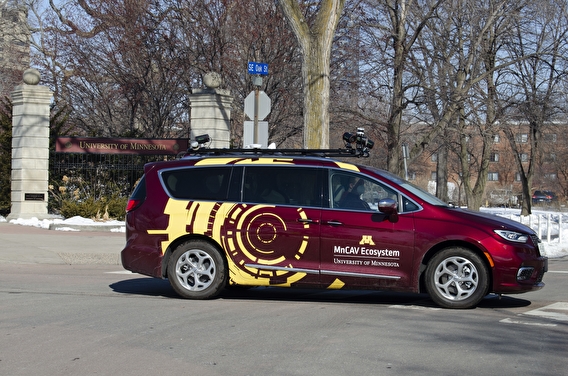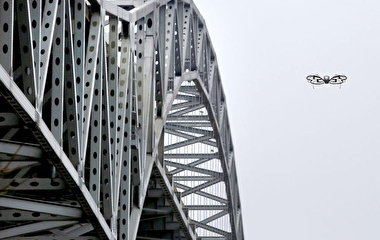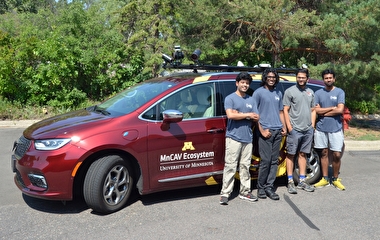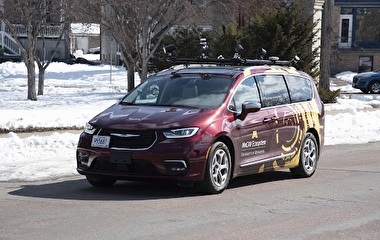
Connected and automated vehicles (CAVs) hold promise for improving transportation operations—but could also provide pathways for “malicious actors” to compromise vehicle security, said Rafael Stern, a U of M assistant professor, in a recent CTS webinar.
Stern, with the Department of Civil, Environmental, and Geo- Engineering, presented highlights from Connected Vehicles and Cybersecurity—A New Frontier of Risk. The article is part of the CTS Future of Mobility series.
Other webinar presenters were Professor Rajesh Rajamani from the Department of Mechanical Engineering, Gina Baas from CTS, and Thomas Johnson-Kaiser from MnDOT’s Connected and Automated Vehicles office.
Cybersecurity
CAVs are basically “computers with wheels,” Stern said, and as such, they provide many avenues for cyberattacks. He first described the more obvious, overtly alarming forms. If a malicious actor is familiar with the software that a given CAV is using to make decisions, this could be exploited to alter the driving behavior of the vehicle. For example, in one experiment, researchers showed that a STOP sign could be altered with tape so that the vehicle reads it as 45 MPH. “This has big implications, and it’s not a very sophisticated hack,” he said.
These sorts of hacks, however, would get noticed and fixed immediately. More subtle cyberattacks—ones that cause only slight deviations in driving patterns on any given vehicle—could have even more widespread effects while going virtually undetected.
“If such an attack were released on all vehicles of a specific make and model, even just slightly more aggressive driving could cause a network-wide increase in delays, fuel consumption, and emissions without a clear way to pinpoint the source of the issue,” Stern said.
Researchers, he continued, need to work with legislators, manufacturers, and agencies to design systems that are resistant to these kinds of attacks. A way of detecting disruptions in overall traffic flow is needed—perhaps using artificial intelligence, which has unexplored potential for identifying anomalous signals.
Stern stressed that CAVs offer the potential to improve transportation operations: They could increase access to services for people who cannot drive and reduce both fuel consumption and traffic jams by driving smarter than people do. “But they also have the potential to be compromised,” he warned.
Winter conditions
Rajamani discussed a different challenge posed by CAV technology: winter driving. His article, Addressing Challenges for Autonomous Vehicles on Winter Roads, is also part of the Future of Mobility series.
Much of today’s CAV technology was developed primarily in warmer climates such as California, Arizona, Texas, and Florida, with a focus on advancing automation past Levels 3 and 4. However, many basic, Level 2 CAV functions—such as lane keeping—tend to fail when introduced to the snow and ice of the Midwest.
“When it comes to states with significant winter and snow seasons, very little testing and deployment have occurred,” Rajamani said.

Using the MnCAV test vehicle, Rajamani and his research team have been testing the limits and possible workarounds for CAVs in winter conditions. Cameras, they’ve found, tend to fail at reading lane markings when there’s snow or ice cover on the road. Lidar is a potential solution, but it requires extensive, hyper-accurate 3D mapping to function. Similarly, GPS could function even in inclement weather, but it requires real-time corrections to obtain accuracy to within a few centimeters (current GPS is only accurate to within a few meters).
Rajamani’s team has been experimenting with “sensor fusion,” which integrates a variety of different sensors that cover for each other’s weaknesses. The team is also planning to use Minnesota’s MnCORS network (originally used for land surveying) to improve the accuracy of GPS.
Artificial intelligence is another avenue that could be explored, Rajamani said. He noted that humans often use the wheel tracks of other vehicles to stay within lanes when markings are not visible, and CAVs could potentially be trained to recognize these and other cues.
“We may not see significant improvement for many years to come unless we—meaning states like Minnesota—take the initiative,” Rajamani concluded.
MnCAV Ecosystem
Gina Baas, associate director of CTS, gave an overview of ongoing projects and general updates about the MnCAV Ecosystem—the U of M’s umbrella program for CAV research, engagement, and workforce development:

- 2021 Chrysler Pacifica Hybrid: MnCAV has an experimental, Level 3 CAV that researchers within the ecosystem can use for projects. The vehicle was demoed in Drive Minnesota, a promotional road trip that assessed CAV infrastructure and policy readiness across the state last year.
- Center for Connected and Automated Transportation (CCAT): CTS is one of the research partners in the University of Michigan’s CCAT, a regional USDOT University Transportation Center. Minnesota researchers will leverage the experience of the ecosystem to prepare for broad-scale CAV development as part of a safe and equitable mobility system.
- Third Annual CAV Career Pathways Camp: This summer program introduces high school students (grades 10–12) to CAV technology and career opportunities. The 2023 program is scheduled for August 7–11.
“We have interesting and exciting work going on at the University, and we look forward to sharing more about it in the months and years to come,” Baas said.
MnDOT CAV projects
Johnson-Kaiser gave an overview of CAV projects at MnDOT:
- CAV shuttle pilots: MnDOT is testing the use of CAVs as shuttles in urban, suburban, and rural environments across the state. Pilot programs are ongoing in White Bear Lake and Grand Rapids, and a program in Rochester wrapped up in summer 2021.
- Automated truck-mounted attenuators: These automated, unmanned vehicles can be programmed to follow a manned “lead” vehicle. MnDOT has been focusing on integrating these into road maintenance operations as a way of minimizing human risk in dangerous work zones.
- Community-Driven CAV: This study, part of the Minnesota CAV Challenge, aims to put communities at the forefront of CAV decision making. The program, in St. Paul’s creative enterprise zone, includes community listening sessions, workshops, and an upcoming action plan to provide a framework for future projects.
“Connected and automated vehicles are going to be an important part of our future of transportation,” Johnson-Kaiser said. “At MnDOT, we’re looking to plan and prepare for how this technology could potentially impact Minnesotans.”
Writer: Sophie Koch


